House of the future; a home designed for life
How will we live when we’re older? We paid a visit to the house of the future to find out.
Written by stannah

When we think about a House of the Future, gleaming Jetsons style homes with a strong sixties allure comes to mind. However thrilling the idea of living in a high-tech apartment in space might seem, it is not what we mean by a “house of the future”.
We can have a little bit of hi-tech fun while we’re at it though. When it comes to smarter living, there are some interesting technological developments in the pipeline.
And since we all know that today’s tendency is to grow older and therefore age in place, we wanted to examine what our houses could look like in the near future. How will, or should, they look? What kinds of exciting, fun prospects are out there, and how will our houses provide us with a more comfortable life?
Join us on a journey into our future!
Table of contents:
Aging in place in a house of the future, keeping your independence.
Homes of the future with an “Elderly-friendly design”.
How does a Stannah lift fit into your house of the future?

Aging in place in a house of the future, keeping your independence.
We’ve written other articles about aging in place (like this one) focussing on how you can adapt your house so that you can live independently for longer. Now, let’s look at how houses can be updated, keeping the future in mind. Your future self will thank your for having thought about how to live a comfortable life in your own house!
What is Domotica?
Domotica is basically a process of home automation, making it a ‘smart home’. It comes from the Latin word Domus for house, and Robotica for ‘remotely monitor’ or ‘control’. It’s not as futuristic an idea as it sounds though, as it’s been around since the 80s. The idea was to control lights, air-conditioning and security with one link that controlled all three elements.
Nowadays, it’s not thought of as something only for industrial or military settings, but rather it’s also being used in domestic settings. In other words, it involves setting up the control and automation of systems like heating, lighting, ventilation, air conditioning and home appliances like washer/dryers, ovens, fridges etc. This also means being able to lock and unlock your doors and windows remotely, using Wi-fi.
European organisation “ Living Tomorrow” specialises in examining the future of different themes, like the future of cities. They researched the idea of smart homes and smart streets and according to their estimations, this year alone 25 billion devices will be connected to the internet. We’ve arrived at a point where the growth of “the internet of things” is unstoppable. It’s therefore very likely that in our future houses we will control certain settings and devices from the comfort of our smart phone, wherever we are. Some things are already possible today! Examples are home monitoring systems without cameras or controlling your tv with your smart phone.
How does this development relate to seniors? Well, being able to control your curtains or kettle from your car on your drive home is awesome, of course. But what really is life changing, is that your house learns your patterns after a while. Your house would know, for example, when you get up in the morning, so it can go ahead and prepare your coffee for you. Your house can also remind you to take your medicine, or when you’re running out of something important. It can even warn you when there is air pollution or create more sustainable and economic energy usage. The house proactively adjusts to your wants and needs. You know how nowadays people can’t live without their phone because their whole life is on it? Domotica will make you feel that way about your house, an invisible butler, nurse and friend, all taking care of you and not in a creepy robots-are-taking-over-the-world-way!
Living Tomorrow actually built a smart home in Brussels that people can visit to get an idea about what their future holds.

Homes of the future with an “Elderly-friendly design”.
As we’ve established, the population of the world is getting older, and quickly. Cities are being adjusted to meet senior citizen’s needs, and their houses are a major part of that.
AAA (Agile Aging Alliance) founder member McCarthy and Stone has commissioned a far-reaching report into how smart technologies in the home could transform independent living for future older generations. This report was focused on the UK, but is also relevant for other western countries. The report “Neighbourhoods of the Future” is a report covering the following subjects: Better homes for older adults – improving health, care design and technology.
This report has been drawn up with the next generation of older adults in mind, meaning the generation of Babyboomers: “is not only the largest generation of older adults the UK has ever seen, but also the most educated, financially secure, technologically aware and experienced. It is a generation accustomed to the service economy, not just as customers, but also as suppliers.”
Architect and housing expert, Judith Torrington, explains in the report why the housing stock in the UK is not well-adapted for older people. This is because a typical home is designed for a family, with 3 bedrooms and a garden. At a time of significant UK housing shortage for the elderly, a large portion of seniors live in houses that were designed for bigger households. Even though many older people have said they want to move to smaller, more manageable homes, there are not enough houses to meet the growing demand. Unfortunately, the existing houses that were specifically designed for seniors only accommodate a relatively small number of elderly people.
Judith Torrington continues to explain that with age, almost everyone will suffer from loss of mobility and increased difficulty in moving around.
Some of the difficulties older adults encounter can be met by adapting existing homes, which will allow people to live independently in their houses for a longer time. Judith Torrington says these adaptations include:
- Fitting handrails
- Stairlifts
- Replacing bathrooms with wet-rooms
However, there are still issues as people grow older. People lose their eye sight as they age, which can result in them falling in their houses. Of course, dementia is also a challenge, as people could burn pans, turn on the gas but not light it, and put themselves in other similar dangerous situations. Some houses don’t meet these safety standards, which can lead to hypothermia due to lack of isolation or inadequate heating. “Fortunately, the need for more and better-designed age-appropriate housing in the public and private sector has been recognised and supported across the political spectrum.” says architect Judith Torrington.
Fun, futuristic products that will make our golden years a pleasure!
We’ve put together a list of some fun and (more importantly) helpful products that were designed for current and future older adults:
- I Walk active: This 21st-century rollator is designed to take away the barrier that declining mobility creates. The active walker has intuitive sensors, e-drive functionality and cloud-based services. It combines an array of technologies and was created to restore loss of independence for people with reduced mobility, stigma free! The company who designed it has even won the prestigious AALA award. Have a look at their pitch below to find out more about the product:
- AXOSUIT: is a 3-year project that aims to bring back full body mobility, allowing users to continue to be able to go about their day-to-day activities. The project is a collaboration between 3 universities and 5 companies who are active and experienced in assistive devices. It looks like an amazing project
- Ironhand: A wearable, soft robotic glove with add-on exercise games! This amazing glove has been created to help people get back hand functions they may have lost due to aging or age-related conditions. With the glove, you’ll be able to do everyday tasks again!
How does a Stannah lift fit into your house of the future?

As Architect Judith Torrington has said, installing a stairlift is a great solution for people to be able to stay in their houses longer.
A stairlift gives you all the mobility and safety you need when going up and down the stairs, and it will give you back the control over your entire home. Making elderly people feel safe again in their own home, and their families have peace of mind knowing that their loved one is independent in a home where they feel safe.
The stairlift is an accessible piece of technology that might very well be in most people’s future, easily installed, low maintenance and adaptable to the user’s needs. Enabling one to stay in the home they love for many years to come.
Related Articles:
What is a Stairlift? 40 Years of Redefining Standards
The Arthritis Suit Experience: Walk a Mile in Someone Else’s Shoes
Book review: Allan Karlsson, 100 years old and still looking for adventure!
